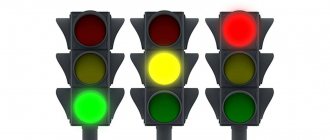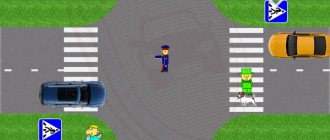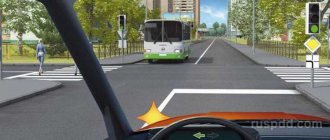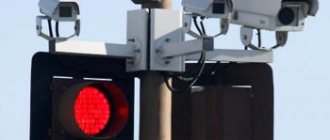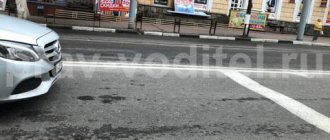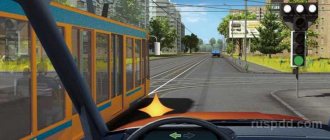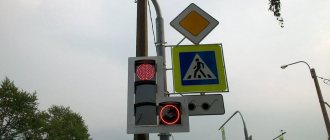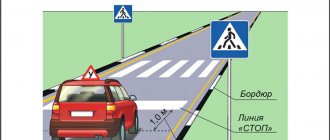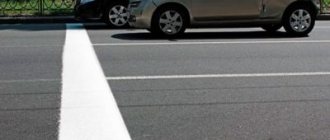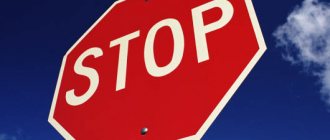What is the fine for running a red light?
The sanction for movement despite the prohibition of the signal is established in Article 12.12 of the Code of Administrative Offenses
The fine for driving through a red light is 1,000 rubles (both for ignoring the red signal and for failure to comply with such a gesture from the traffic controller). Please note that the ban applies not only to red, but also to yellow signs. A fine in the amount indicated above also faces those who drove not only through a prohibiting signal, but also through a traffic signal that was not allowed (if there are several traffic light sections).
In situations where the signal does not change for a long time, we can talk about a traffic light malfunction. After making sure that the signaling system has failed (after waiting time), the driver can continue driving with extreme caution, allowing pedestrians to pass (despite the absence of a zebra crossing).
If the signals of the traffic controller and the traffic light are not synchronized, preference should be given to the traffic controller present. Even if the light prohibiting movement is on, and the traffic controller gives permission, you need to continue on your way. Responsibility for a possible offense in this case lies entirely with the traffic controller, who motorists cannot disobey.
What is the punishment?
Most drivers drive along the road without always paying attention to traffic lights. Sometimes mistakes are made due to inattention, sometimes because the offender belongs to the category of reckless people. Crossing the road at a red light or ignoring the instructions of the traffic controller, according to Article 12.12 of the Administrative Code, Part 1, is subject to punishment. The fine for a misdemeanor will be 1000 rubles.
If a car passes while the red and yellow lights are on at the same time or when the light is yellow, the actions will also be considered a violation (you can find out what the consequences are when driving through a yellow traffic light here). But in such cases, it is possible to prove to the court that although the offense was committed, there were mitigating circumstances. For example, the driver did not stop when the signal turned yellow because he would have had to apply emergency braking.
At the railway crossing
Traffic lights on railway roads and road intersections have the same status. If there is a red signal on when passing a railway crossing or when a traffic controller prohibits it, the penalty is established by Art. 12.10 Code of Administrative Offences. The violator faces a fine of 1,000 rubles or his license will be taken away for 12 months.
It will also be considered a violation to drive on a red light with an installed reversible traffic control device, park and stop on the rails, attempt to drive through the rails not at a crossing, driving with a barrier closed or starting to close.
If you pass a reverse traffic light
Driving through a prohibition signal given by a reversing traffic light is, in terms of the degree of danger, equivalent to driving in oncoming traffic. Punishment for a misdemeanor is imposed on the same grounds as driving through a red light of a simple traffic light and is a fine of 5,000 rubles (Article 12.15 of the Code of Administrative Offences, clause 4), or the driver is deprived of his license for 4-6 months (Article 12.12 of the Code of Administrative Offenses, paragraph 4). part 3). If the mistake with travel is repeated - deprivation of rights for a year (Article 12.15 of the Code of Administrative Offences, part 5).
What are the consequences of repeat violation?
If the violation is repeated, the punishment will become more severe.
Article 12.12 of the Administrative Code, clause 3 establishes a monetary penalty for such an offense, which amounts to 5,000 rubles. If the court decides that a monetary penalty would not be a severe enough punishment, the driver will be deprived of the right to drive a car. The period of deprivation of rights can be 4-6 months. Reference. A violation is considered repeated when it occurs within a year after the first trip.
For more information about the punishment for repeatedly running a red light and how to avoid it, read this article.
What happens when crossing the stop line?
At signalized intersections there is a stop line representing a visual traffic limiter. It can be indicated by a sign or markings, which are arranged both together and separately. The fine for violation is imposed in the amount of 800 rubles according to Article 12.12 of the Code of Administrative Offenses (clause 2). Signs require drivers to stop at signalized intersections. The marking means that the driver is required to stop at an unregulated intersection if there is a corresponding sign.
The video below explains the punishment for crossing the stop line.
What is the fine for running red again?
Traffic police fines increase significantly with repeated violations of such legal norms. Repeated offense (Part 3 of Article 12.12 of the Code of Administrative Offenses) entails a sanction in the form of a fine of 5,000 rubles or deprivation of rights from 4 to 6 months. An offense is repeated if the same illegal act was previously committed and twelve months have not yet passed from that moment.
An offense is considered committed again (repeatedly) when driving through any prohibiting traffic light signal (including a missing permitting signal). So, if for the first time a motorist drove through a red light, and then within a year made a turn at an intersection when the green arrow was “extinguished,” his offenses are considered similar.
How and when to pay the fine?
The driver who initially violates the traffic rules gets off with a fine. A special notice with the amount and details is sent to his home.
If the driver knows that he ran a red signal, but has not received the appropriate notification of a fine, there is no need to waste time. It is quite possible that the notice was simply lost. But this is not a reason not to pay the fine.
What to do if the “penalty” letter does not arrive:
- Go to the State Services portal, the traffic police website or your online bank to track the presence of a fine.
- Don't waste time. If 60 days pass from the date the fine was issued and the payment is not made, an administrative case will be opened against you and you will be fined for late payment.
Driving beyond the STOP line at a prohibiting signal
Crossing the stop line, regardless of the prohibition of the signal, will be an offense if:
- This is a controlled intersection (there is a traffic light or traffic controller);
- During the drive to the stop line the red light was on or there was a traffic controller's prohibiting sign.
The stop line must be indicated by appropriate road markings and a “Stop” sign. Sanction: fine of 800 rubles. It is noteworthy that a stop sign means that you must stop directly at a controlled intersection in front of the traffic light. The presence of a stop line requires stopping at uncontrolled intersections with the simultaneous presence of a “Stop” sign.
How far is the stop line before the traffic light?
At a controlled intersection, the placement of marking 1.12 and the accompanying sign depends on the position of the traffic light - it must be clearly visible to the driver. If the device is located on the side of the roadway, the stop line is drawn 3-5 meters before it. When the traffic light is located at the top, the distance increases to 10-20 meters. Before railway crossings, a stop line is drawn 5 meters before the traffic limiter (barrier, semaphore) or 10-20 meters before the crossing.
Note!
The “STOP” sign is installed flush with the line. If they diverge significantly, the sign has priority.
Entering an intersection where there is a traffic jam
You should not enter an intersection if there is a traffic jam ahead, since the legislator equates this offense to driving through a prohibitory sign. The driver is forced to remain at the intersection, thereby creating a traffic jam and the impossibility of movement for other cars. During traffic jams, there is always a risk of committing a traffic violation, and crossing the intersection behind which it has formed only increases the danger of an emergency situation.
The fine for this violation is 1000 rubles or deprivation of rights if the offense is repeated within a year.
What cars can go on red?
There are cars that are allowed to drive through prohibitory signals. This moment often causes accidents. That is why the driver must be doubly careful at an intersection. When driving through a green light, you cannot be 100% sure that a car speeding through a red light will not enter the intersection.
Special vehicles that can drive through intersections despite prohibition signs:
- fire trucks;
- ambulance;
- police cars.
Vehicles that are allowed to pass through a red light must be equipped with a special alarm system - audio and visual. All road users are required to give way to such vehicles.
If the driver does not allow the special vehicle to pass, he faces a fine from the traffic police.
Crossing railway tracks at a prohibiting traffic light signal
Part 1 of Article 12.10 (Administrative Code) provides for sanctions for crossing railway tracks on a red line: a fine of 1000 rubles or deprivation of rights from 3 to 6 months. An equivalent offense with the same penalty is the passage of railway tracks despite the prohibitory sign of the person on duty at the crossing, bypassing the crossing, a stop on the railway tracks, or passing the crossing at the time the barrier is closed (including closing).
A repeated offense involves deprivation of a driver's license for one year (Part 3, Article 12.10).
Penalty for entering an intersection in case of congestion
Regulates the procedure for consideration and establishes the amount of a monetary penalty in the situation of leaving an intersection in the event of a traffic jam of the Code of Administrative Offences, Part 1 of Art. 12.13. The law prohibits driving into an intersection and adjacent areas (with markings 1.26 or “waffle iron”) if traffic ahead is extremely difficult. Movement is permitted only in the case of a turn, when the driver does not actually create a congestion for the transverse direction.
So, if the driver entered an intersection with a traffic jam and further aggravated the situation, a fine of 1,000 rubles is provided. In practice, traffic police officers issue fines in such cases quite rarely, since in the Rules the concept of “congestion” does not have an unambiguous interpretation. However, in a situation where traffic is completely paralyzed due to the fault of one of the drivers, the risk of receiving a penalty becomes quite real.
How to pay a fine with a 50% discount
Penalties can be paid:
- Through the bank;
- At the post office;
- Through Internet banking;
- Through payment terminals.
Payment of fines within the first twenty days from the date of registration of the resolution implies a discount of 50% of the original amount. This system applies to fines resulting from:
- Travel on red or yellow, as well as a traffic ban from the traffic controller;
- Violations of rules at railway crossings.
Committing a second offense within a year means paying a fine without any discounts.
Is it possible to challenge a fine for driving through a prohibitory signal?
If a motorist has sufficient grounds to challenge the fines, he has the right to do so through the court. The judicial authority in this case is determined by the plaintiff himself: at the place of his registration or at the location of the traffic police, whose officer issued the decision on the offense. District courts are authorized to consider such cases.
For the court, along with the statement of claim, you must provide the following documents:
- Protocol on administrative violation;
- Resolution (on imposition of penalty);
- Technical passport of the car;
- Driver license;
It should be remembered that the right to go to court is retained for ten days (from the date of execution of the decision).
